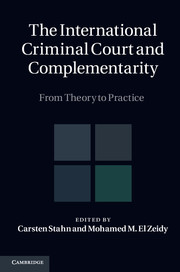Book contents
- Frontmatter
- Contents
- Acknowledgments
- Foreword by HE Judge Sang-Hyun Song
- Foreword by Patricia O’Brien
- Foreword by Silvia A. Fernandez de Gurmendi
- List of abbreviations
- Introduction: bridge over troubled waters?
- PART I General reflections
- PART II Origin and genesis of complementarity
- 4 The genesis of complementarity
- 5 Reflections on complementarity at the Rome Conference and beyond
- 6 The rise and fall of complementarity
- PART III Analytical dimensions of complementarity
- PART IV Interpretation and application
- PART IV (Continued) Interpretation and application
- PART V Complementarity in perspective
- PART VI Complementarity in practice
- Index
- References
6 - The rise and fall of complementarity
from PART II - Origin and genesis of complementarity
Published online by Cambridge University Press: 05 November 2014
- Frontmatter
- Contents
- Acknowledgments
- Foreword by HE Judge Sang-Hyun Song
- Foreword by Patricia O’Brien
- Foreword by Silvia A. Fernandez de Gurmendi
- List of abbreviations
- Introduction: bridge over troubled waters?
- PART I General reflections
- PART II Origin and genesis of complementarity
- 4 The genesis of complementarity
- 5 Reflections on complementarity at the Rome Conference and beyond
- 6 The rise and fall of complementarity
- PART III Analytical dimensions of complementarity
- PART IV Interpretation and application
- PART IV (Continued) Interpretation and application
- PART V Complementarity in perspective
- PART VI Complementarity in practice
- Index
- References
Summary
‘Positive’ complementarity is a vision of the Rome Statute embraced by the Office of the Prosecutor in the early years of the Court as a means of generating cases. Based upon a novel interpretation of Article 14, states were encouraged to refer ‘their’ situations, although in practice it was always understood that they were directing the Court to the rebels in an internal armed conflict. It required judges to develop an approach to Article 17 by which they read in the criterion of ‘inactivity’ as a ground for admissibility. The approach worked, to the extent that it provided suspects for the first trials, but it did little or nothing to advance the fundamental principle, set out in the Preamble to the Statute, by which it is ‘the duty of every State to exercise its criminal jurisdiction over those responsible for international crimes…’.
Introduction
Complementarity, it is often said, lies at the heart of the vision of the International Criminal Court. Trial Chamber I has described complementarity as ‘one of the cornerstones of the Statute’. In earlier manifestations of international criminal justice, the issue had not really arisen in the same way. International criminal tribunals have always required some normative framework in order to delineate the cases they are to try from those left to the domestic courts or that simply went unpunished. This has usually taken the form of a division of labour between national and international jurisdictions. It was generally addressed as a jurisdictional issue, rather than a matter for the admissibility of a case.
- Type
- Chapter
- Information
- The International Criminal Court and ComplementarityFrom Theory to Practice, pp. 150 - 164Publisher: Cambridge University PressPrint publication year: 2011
References
- 7
- Cited by

